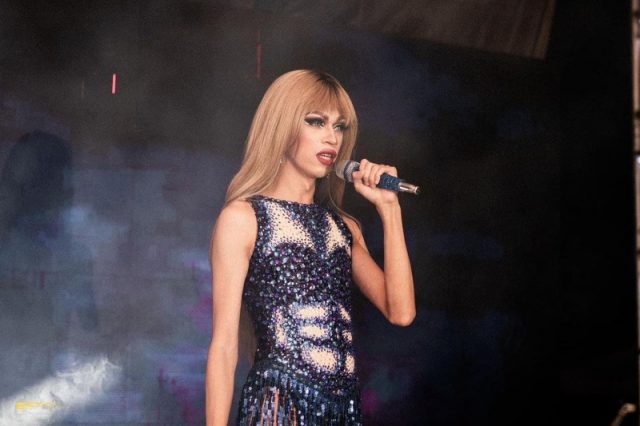
The tribute music scene has evolved time and again since it first emerged more than 60 years ago.
Beginning with Elvis impersonators, tribute acts garnered somewhat of a “grubby” reputation through the 1970s and ’80s. They became synonymous with glitter, wigs, jumpsuits and elaborate stage props — frowned upon by anyone with an ounce of self-perceived integrity.
However, while these acts mainly existed as tributes to music no longer accessible, in recent years we’ve seen an increase in artists being tributed while they’re still active.
For the many Australian “Swifties” left without tickets for the recent Eras tour, tribute shows offered a financially viable alternative. Interstate fans who couldn’t embark on a “swiftcation” could instead see Adelaide sister duo Reputation.
In Melbourne, drag star Taylor Sheesh performed “The Errors Tour” for a crowd of thousands, while Taylor Swift performed about a kilometer away at the MCG.
But while they say it’s the sincerest form of flattery, can tribute acts really come close to the “real thing”?
A ‘real’ experience?
It’s not only affordability and accessibility that make tribute shows appealing. Experiencing live music in a smaller, dedicated live music venue also provides audiences with a much more personal experience.
Perth-based Ed Sheeran tribute singer Joe Boshell said, as a fan, he would much rather experience his musical heroes in a more intimate setting. “Obviously these tributes are not the real guys but the sound can be better [at smaller venues],” he said.
“You feel like you’re at a gig rather than watching it from miles away on the [stage-side] TV screen.”
The experience at a stadium can sometimes feel detached and isolated. Not to mention, climate change and extreme weather events are making it increasingly difficult to hold large festivals and outdoor stadium concerts.
Smaller venues are usually indoors and offer easy access to the bar and toilets, liberating people of the conundrum of giving up a hard-earned vantage point to relieve a bursting bladder.
At tribute shows, you can even initiate a dialogue with the band onstage, or share a drink with them afterwards. They’re often happy to chat as fellow fans of the music — and don’t have to be whizzed off to a nearby hotel.
This experience surrounds you with friends, loved ones and like-minded individuals. Tribute events aren’t just a spectacle, but an immersive, participatory outlet.
Authenticity in imitation
You might be wondering: should the original artist hold precedence when it comes to performing their music?
While it seems like a straightforward question, the answer isn’t always simple. As ageing rockers become distant from their original ethos, some argue they may as well be performing a tribute to their former selves.
For example, Morrissey of fabled indie pop band The Smiths has little in common with his 1980s back catalogue that he still performs today. Many fans feel “betrayed” at his political transition from leftist torchbearer for disillusioned youths to an outspoken rightist provocateur.
Another consideration is that tribute acts aren’t just imitative; they have their own personality.
Graham Sampson, the lead singer of The Smiths tribute band, The Smyths, said their audiences desired a more individual performance. They want the band to “be themselves” rather than provide a “pantomime” version.
Impact on local music scenes
Accessibility is a major factor contributing to the popularity of tribute scenes throughout Australia. Perth had more than 70 ticketed tribute shows dedicated to ska, punk and Britpop in 2022 alone – and as many as five tributes to Oasis over the past few years.
Tributes now jostle for space in a competing musical landscape, striving to prove their legitimacy as cultural ambassadors of music history. This competition is driven further by the fact that our love for old music is far from shrinking. In fact, music of the past increasingly dominates the music charts today.
At the same time, tributes reflect our society’s desire for streamlined consumption: getting what we want, when we want it. They are therefore a corrosive agent in local original music scenes.
An abundance of tribute shows gives fans a choice of what music they can experience on any given night, rather than having to “take a punt on an original band”, as one Perth promoter grimly said.
This is where tribute acts differ from “cover bands”. Cover bands play a mix of hits that appeal to a broad demographic, rather than targeting individual taste groups.
The future of tributes
Swedish rock band The Hives is now looking to franchise tribute bands across the globe (seemingly drawing on The Wiggles’ blueprint). We may be on the cusp of a new era where tribute shows can achieve commercial prominence.
In a similar vein, the Netherlands now has a tribute-based Battle of the Bands TV show. And this isn’t a big leap from the 2005 reality TV show Rock Star: INXS, in which contestants battled it out to replace deceased lead singer Michael Hutchence.
“Tributing” is undoubtedly dribbling into all areas of the music industry. We live in a world where The Rolling Stones continue to make commercially successful music that offers little more than a reminder of their younger years, and where AI is used to reincarnate deceased musicians and release songs written decades ago.
Clearly, tribute shows aren’t the sole contributors to a lack of forward propulsion in music. Perhaps, for the time being, we should focus on what they do offer: an affordable, accessible and intimate space to celebrate the music we love with others who love it, too.![]()
Colin Outhwaite, PhD Candidate, Western Australian Academy of Performing Arts, Edith Cowan University. This article is republished from The Conversation under a Creative Commons license. Read the original article.






